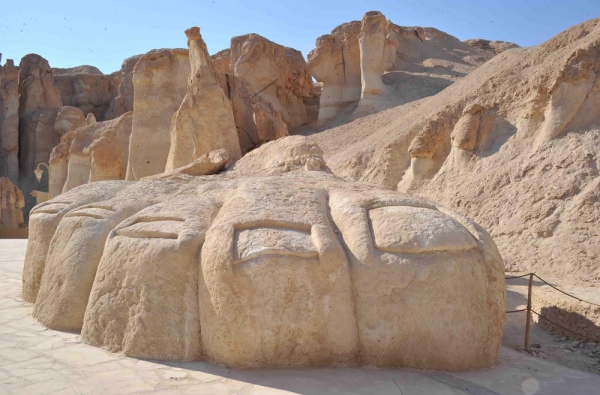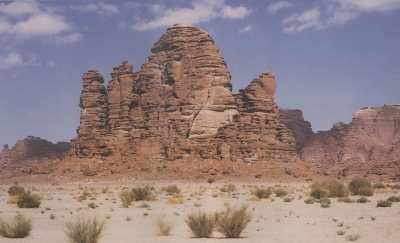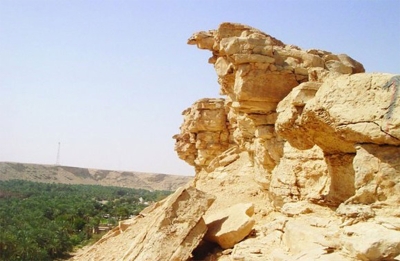
Al-Qarah Mountain, or Qarah Mountain, is one of the mountains in the Kingdom of Saudi Arabia, located east of al-Hufuf City in the Eastern Province. It is approximately fifteen km from al-Hufuf City, situated in the lush oasis of al-Ahsa Governorate. The mountain stands 210 m above sea level and is the second smallest mountain in the Kingdom after Mount Abraq al-Kabreet.
The base of al-Qarah Mountain covers an area of approximately fourteen km². It measures approximately one thousand m from north to south and eight hundred m from east to west.
The naming of al-Qarah Mountain
There are various historical accounts regarding the name "al-Qarah" given to this mountain. One account attributes it to a pre-Islamic tribe known for its skill in archery; the tribe was named "al-Qarah" due to the exceptional proficiency of its people in shooting arrows. Some believe that the meaning of the name refers to a small, solitary, round black mountain that rises high into the sky.
Some historical texts suggest that al-Qarah Mountain was the one referred to by the name "al-Mushqar," which was mentioned in ancient times by historians and travelers. Historians have differed on the exact location of "al-Mushqar." Some say it is a place in Hejaz, others suggest it is a valley in Aja, one of the Tayy Mountains, or a fortress in Bahrain, with the latter being the most widely recognized.
Others have mentioned that al-Qarah was named as such because its southern side is connected to a large, unusually shaped hill with caves of varying sizes. Atop this hill is a large rock intricately carved with three heads: one facing south, resembling a woman’s head; another facing north, resembling a man’s head; and the third in the middle, resembling a lion’s head. This mountain is still known today as "Ras al-Qarah" Mountain, which is the one referenced by Arab geographers.
History of al-Qarah Mountain
The formation of al-Qarah Mountain dates back over 2.5 million years. It is surrounded by four historic villages: al-Twaitheer, al-Dalwah, al-Tuhaymiya, and al-Qarah, from which the mountain takes its name. The mountain overlooks vast areas of palm groves, orchards, and villages.
Location of al-Qarah Mountain
On the geological map, al-Qarah Mountain is situated on the eastern edge of the Shedgum Plateau, which links Kuwait and Iraq to the north and ar-Rub' al-Khali (Empty Quarter) to the south. The network of curves and caves in al-Qarah Mountain resulted from a process known as "aerial weathering," where the shape of the rock changes due to rain and rivers rather than groundwater. This has led to the unique mushroom-like rock formations, narrow passages, and caves.
Al-Qarah Mountain is composed of layered limestone with colored strata revealed by erosion. At its peak lies a massive rocky hill known as "al-Mushaiqir." The mountain’s summit has an ancient history dating back to the pre-Islamic era, serving as a residence for the kings of the Kindah tribe, and it was mentioned in the poetry of the poet Imru’ al-Qais.
Caves of al-Qarah Mountain
The caves and grottoes of al-Qarah Mountain have contributed to its fame, making it an archaeological and tourist destination. The mountain contains twelve caves of various shapes and lengths, known for their cool internal climate. The temperature inside remains around twenty °C, even during the hottest summer days when the temperature outside exceeds forty °C.
The temperatures in the mountain’s caves change with the seasons, and their shapes and sizes vary. Among them are: Naga Cave, which can accommodate about five hundred people and is the largest and most spacious; al-Eid Cave, located near Souq al-Ahad; al-Mahyub Cave; al-Ghairan Cave; and Bou Saleh Cave.
Land of Civilizations at al-Qarah Mountain
Al-Qarah Mountain is one of the prominent tourist landmarks in al-Ahsa Governorate. It can be accessed through several routes, including the road passing by Ain al-Khudood, al-Jishah route, or al-Jafr route through al-Shaharin and al-Mansoura.
To enhance the tourism infrastructure at al-Qarah Mountain, the "Land of Civilizations" cultural tourism project was partially opened at the mountain in 2016. This initiative aimed to provide tourists and visitors to al-Ahsa, and particularly to the mountain, the opportunity to explore the project's landmarks. Following the completion of the exterior parking area, visitors can now tour the mountain’s main cave and the stone theater.
Related quizzes
Related articles


